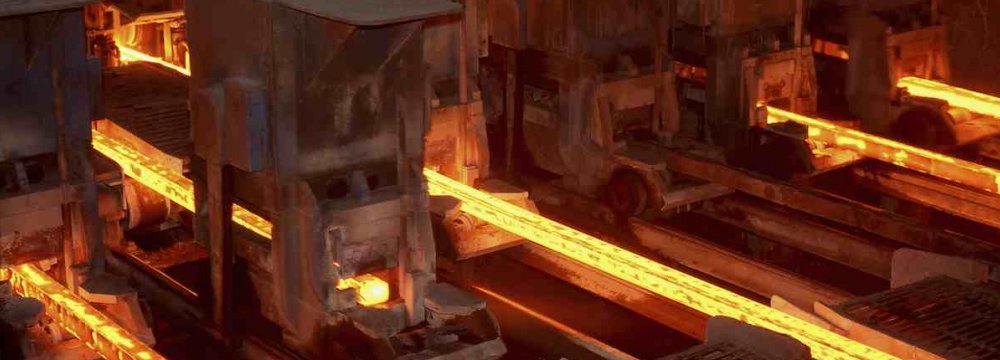
Iran Steel Exports Up 55%

Iran’s major steelmakers exported over 4.12 million tons of crude steel and steel products in the nine months ending December 20, registering a 55% growth compared with last year’s corresponding period, according to the Iranian Mines and Mining Industries Development and Renovation Organization.
Domestic manufacturers exported 479,854 tons in the Iranian month of Azar (Nov. 21-Dec. 20) to register a 117% jump year-on-year.
Khouzestan Steel Company accounted for the lion’s share of total exports by shipping more than 1.4 million tons of blooms, billets and slabs during the nine-month period, registering a 48% growth YOY. KSC’s slabs were especially in high demand, as shipments soared 2,469% to 534,796 tons.

KSC, Iran’s largest semis producer, has continued to improve its position in the Far Eastern slab markets for the past few months. The company signed several contracts back in October and bolstered its market presence in Indonesia, Taiwan and Thailand. The recession-hit domestic construction sector has given KSC even more reasons to further embark on exports.
Mobarakeh Steel Company was the second main exporter. Its exports grew 20% to reach 1.37 million tons of different products, including hot, cold, galvanized, acid-washed, tin-plated, color-coated, corrugated steel coils and strips.
HRC output of Saba Steel Complex–a subsidiary of MSC–recorded a 17,719% upsurge to 21,205 tons.
Together with its subsidiaries, MSC is the largest flat steel producer in the Middle East and North Africa region and Iran’s largest steelmaker, accounting for 1% of Iran’s GDP.
Mobarakeh is also dependent on exports as a lifeline to keep the company afloat, considering the current slump in the local market.
“Meeting domestic demand has always been and will be on top of MSC’s agenda. The company’s expansion, however, depends on expanding exports,” Mehr News Agency quoted MSC’s deputy head for sales and marketing, Mahmoud Akbari, as saying in December.
The third place on the list went to Hormozgan Steel Complex, as it shipped 812,115 tons of slabs during the three quarters and posted a 751% growth YOY.
By putting out 430,285 tons of beams, rebars, coils and tin ingots, Esfahan Steel Company was the next biggest steel exporter. ESCO posted a 2% drop in its shipment record. It was the only major steelmaker to post a decline in exports for the period.
Isfahan-based ESCO (locally known as Zob Ahan-e Esfahan) is Iran’s third largest steel producer controlled by the Ministry of Industries, Mining and Trade. The company, however, is currently in hot waters as it has accumulated about 1.9 billion in debts and filed losses worth $33 million in the last fiscal year (March 2015-16).
The company’s majority stakeholders, Social Security Investment Company (known by its Persian acronym SHASTA) and the Steel Pensioners’ Fund for retired Iranian steelworkers, have tried on several occasions to sell ESCO’s ownership through block sales, but have not been able to attract any buyers. Consequently, the cash-strapped company has not been able to embark on expansion programs and is now struggling to find new export markets.
Khorasan Steel Company took the fifth position among major steel exporters by shipping 51,485 tons, followed by Iran Alloy Steel Company with 30,766 tons and Oxin Steel Company with 16,181 tons.
Steel producers are expected to export close to 5.7 million tons by the end of the current fiscal year (March 2017), according to Rasoul Khalifeh-Soltani, the head of Iran Steel Producers Association.
According to the official, the recovering global steel prices have driven steel producers to increasingly shift their attention to exports.
Steelmakers set a new record last year by exporting more than 4.1 million tons of steel products valued at about $7 billion. Crude exports stood at 1.8 million tons.
Iran is currently the world's 14th largest steelmaker, as it produced 16.4 million tons of crude steel in the 11 months of 2016, registering an 11% growth YOY.
The country aims to become the world’s sixth largest steel producer as per the 20-Year Vision Plan (2005-25), which envisions an annual production of 55 million tons of crude steel per year.
Iranian steel mills have so far materialized 31 million tons of the annual steel manufacture capacity target.


Trump weighs using $2 billion in CHIPS Act funding for critical minerals

Codelco cuts 2025 copper forecast after El Teniente mine collapse

Electra converts debt, launches $30M raise to jumpstart stalled cobalt refinery

Barrick’s Reko Diq in line for $410M ADB backing

Abcourt readies Sleeping Giant mill to pour first gold since 2014

Nevada army depot to serve as base for first US strategic minerals stockpile

SQM boosts lithium supply plans as prices flick higher

Viridis unveils 200Mt initial reserve for Brazil rare earth project

Tailings could meet much of US critical mineral demand – study

Kyrgyzstan kicks off underground gold mining at Kumtor

Kyrgyzstan kicks off underground gold mining at Kumtor

KoBold Metals granted lithium exploration rights in Congo

Freeport Indonesia to wrap up Gresik plant repairs by early September

Energy Fuels soars on Vulcan Elements partnership

Northern Dynasty sticks to proposal in battle to lift Pebble mine veto

Giustra-backed mining firm teams up with informal miners in Colombia

Critical Metals signs agreement to supply rare earth to US government-funded facility

China extends rare earth controls to imported material

Galan Lithium proceeds with $13M financing for Argentina project

Kyrgyzstan kicks off underground gold mining at Kumtor

Freeport Indonesia to wrap up Gresik plant repairs by early September

Energy Fuels soars on Vulcan Elements partnership

Northern Dynasty sticks to proposal in battle to lift Pebble mine veto

Giustra-backed mining firm teams up with informal miners in Colombia

Critical Metals signs agreement to supply rare earth to US government-funded facility

China extends rare earth controls to imported material

Galan Lithium proceeds with $13M financing for Argentina project

Silver price touches $39 as market weighs rate cut outlook

















